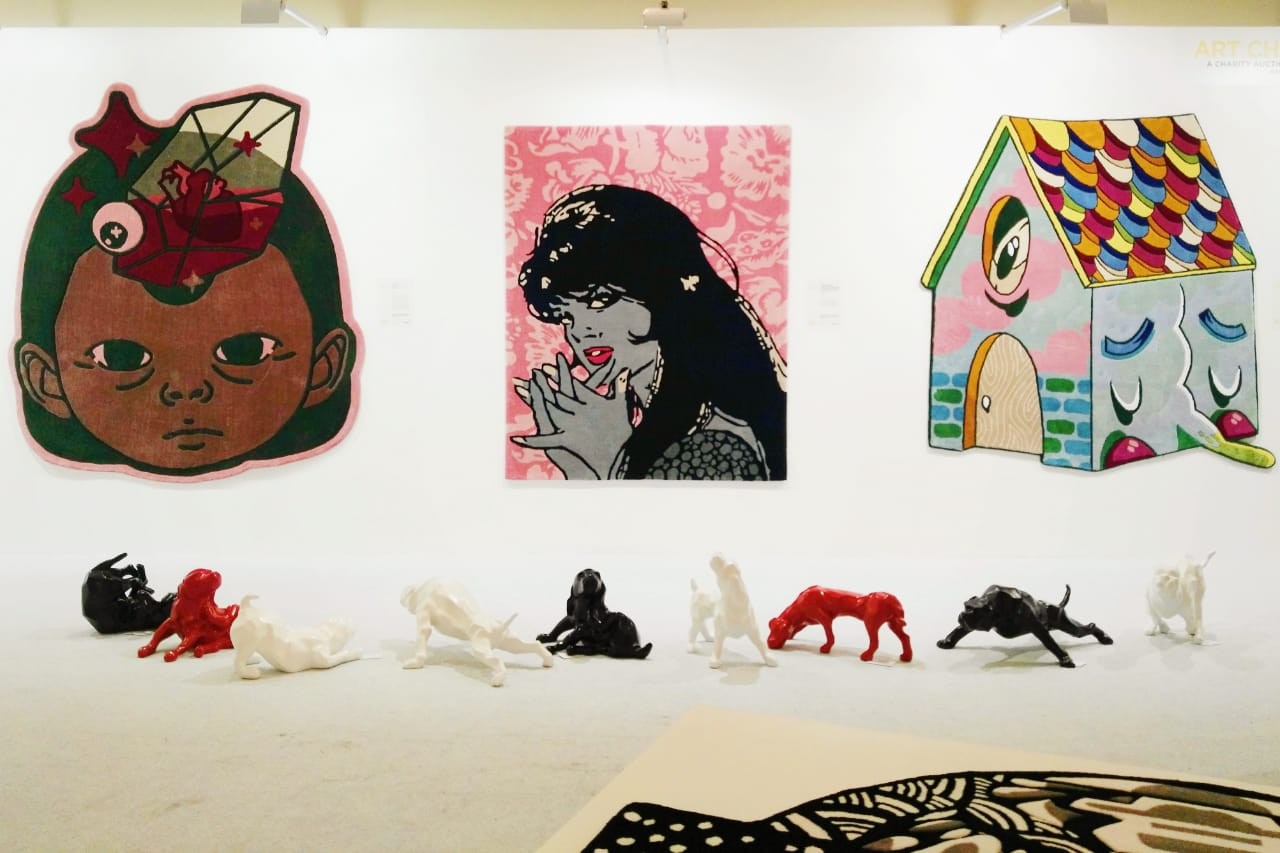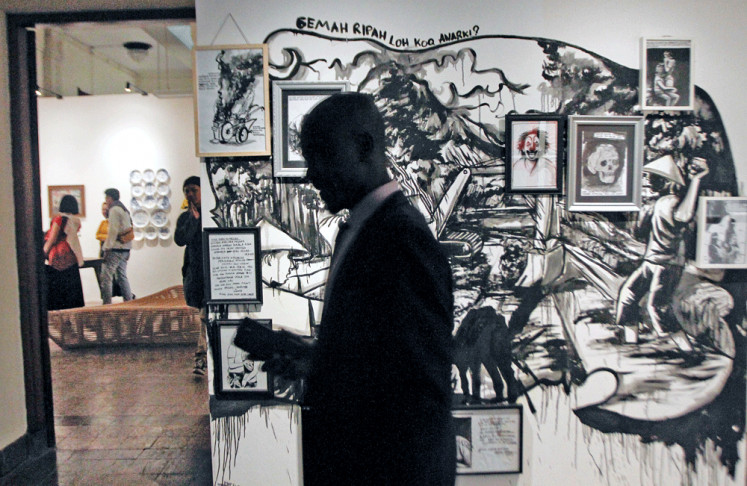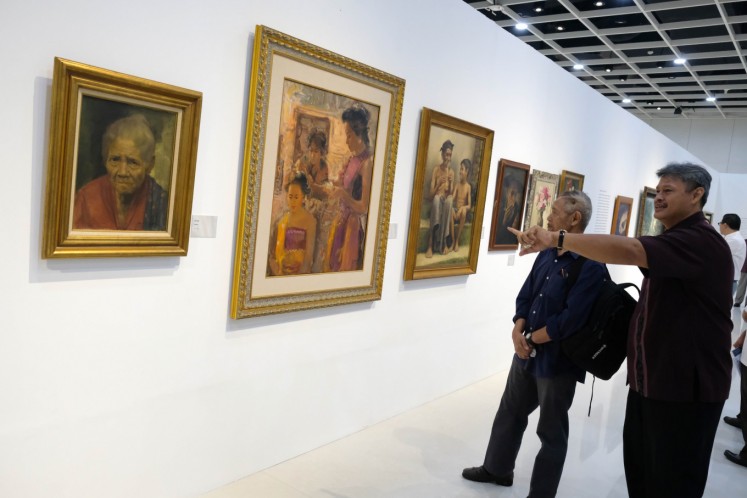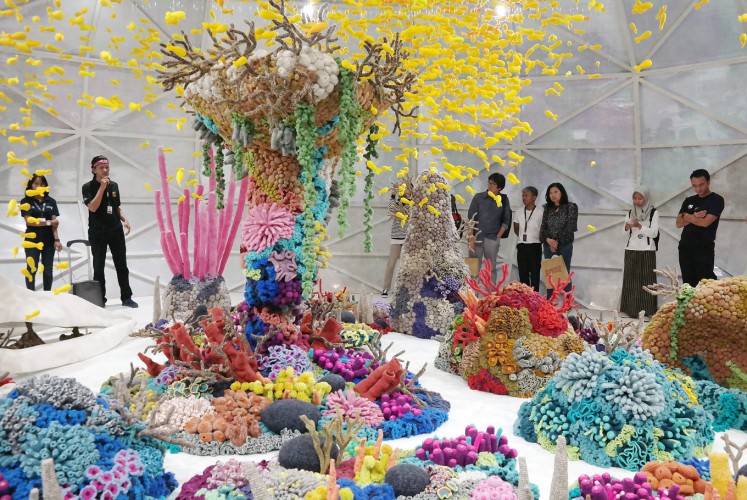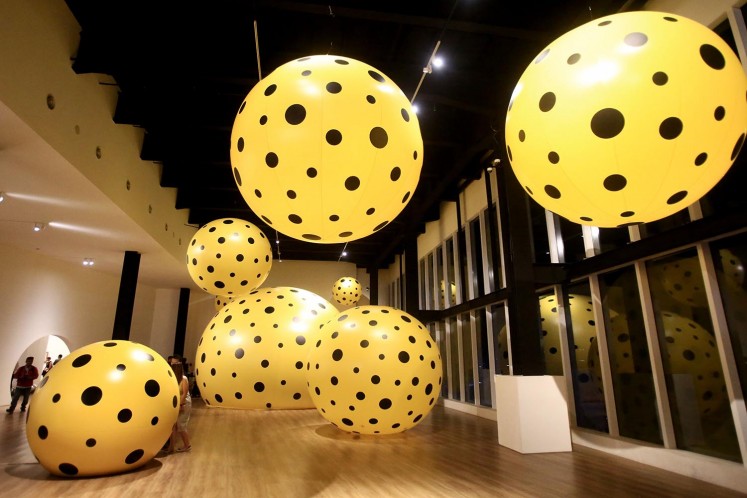Popular Reads
Top Results
Can't find what you're looking for?
View all search resultsPopular Reads
Top Results
Can't find what you're looking for?
View all search resultsArt 2018: Something old, something new
Change text size
Gift Premium Articles
to Anyone
I
t’s been an exciting time for Indonesia’s art scene this year, with existing art fairs setting stronger foundations and new ones stealing attention.
Raden Saleh
The year kicked off with surprisingly good news when a painting by Indonesian master Raden Saleh broke a new record as the most expensive Indonesian piece of art sold at an auction in France in January.
The painting, titled Perburuan Banteng (Banteng Hunt), went under the hammer for 7.2 million euros (US$8.2 million) — much higher than the reserve price of 200,000 euros. It was bought by an anonymous Indonesian collector, according to auctioneer Jack-Philippe Ruellan.
More good news might be around the corner because next year, Ruellan said, another Raden painting, titled Presumed portrait of Alexander Pushkin ( 1841 ), would be put up for auction on Jan. 29, with estimations put at 60,000 to 80,000 euros. The authenticity of this new painting has been confirmed by Raden Saleh experts Marie-Odette Scalliet and M. Werner Kraus.
“The owner of this painting is Greek and he came to us because of the price paid for Perburuan Banteng in January,” Ruellan told The Jakarta Post. “His wife is Indonesian and she had inherited the painting.”
Perburuan Banteng (Banteng Hunt) by Raden Saleh (Courtesy of French auction house Jack-Philippe Ruellan/File)Something New
Indonesia’s art scene welcomed two new events this year — Art Bali and Art_Unltd: XYZ in Bandung, West Java.
Art Bali — initiated by Heri Pemad, the impresario behind ARTJOG, and young Balinese artist Aswino Aji in collaboration with the Creative Economy Agency (Bekraf) — was held in conjunction with the 2018 Annual Meetings of the International Monetary Fund-World Bank Group in Nusa Dua, Bali.
The inaugural “Art Bali: Beyond the Myths” art exhibition, held from Oct. 10 to Nov. 9 this year and which is scheduled to be held annually, featured over 50 works by 39 Indonesian and foreign artists.
Through the selected works, Art Bali and its curators, Rifky Effendy and Ignatia Nilu, were praised for successfully presenting a visual tour de force that not just pleased the eye but also the mind.
A promising development also came from West Java’s capital Bandung — known as one of Indonesian’s contemporary art hubs and home to the country’s oldest fine arts school.
Art statement: A visitor walks in front of Mufti “Amenk” Priyanka’s work during the “Art_Unltd: XYZ” exhibition in Bandung, West Java. (The Jakarta Post/Arya Dipa)This year, the city finally tried to catch up with its counterparts on the art scene, mainly Jakarta and Yogyakarta, which have successfully held annual events like Art Jakarta and ARTJOG.
Bandung hosted the six-day art event called Art_Unltd: XYZ from Dec. 15 to 20, which was organized by Bekraf and ArtSociates Indonesia. It displayed the work of more than 100 artists ranging from the renowned to the younger generation.
In terms of artistic productions in contemporary art, Argus said there was no significant development in popular art hubs like Bandung, Jakarta or Yogyakarta as some artists were working and experimenting with new media art — something that, unfortunately, not all collectors’ preferred: painting.
But next year, he said, could be the right moment to support the development of an art market ecosystem and enhance collectors’ appreciation for new media art. “Art_Unltd: XYZ will hopefully trigger regions outside Java to enhance the art market ecosystem for artists and other creative players,” Argus added.
Fake Painting
Concerns are being raised over the presence of many reproductions, usually the work of late masters that are being passed off as being the real deal.
Fears that these fakes will diminish the quality of Indonesian art have prompted the Indonesian Fine Art Lovers Association (PPSI) to come out with a new book titled Melacak Lukisan Palsu (Tracing Fake Paintings).
The book, with art critic Syakieb Sungkar as editor, is a collection of extensive research-based pieces into the phenomenon by art critics, the media, curators, collectors, and family members of the artists whose work has been forged.
The book also takes an in-depth look at painters such as S. Sudjojono, Hendra Gunawan and Lee Man Fong and the history of their paintings, which are some of the most forged pieces in Indonesia.
Interestingly, in tandem with the book’s release, an exhibition, titled “Maestros and their Followers” was also held, displaying the work of artists who purposely reproduce works by the masters not as forgeries but “tributes”.
Respecting authenticity: Syakieb Sungkar (right), the editor of a book titled Melacak Lukisan Palsu (Tracing Fake Paintings), and prolific writer Goenawan Mohamad admire paintings at the Maestro dan Para Pengikutnya (Maestros and their Disciples) exhibition at Ciputra Artprenuer in Jakarta on Thursday. (JP/Jerry Adiguna)Art Fairs
Prominent art fairs — ARTJOG in Yogyakarta and Art Jakarta — returned this year, while Art Stage Jakarta is scheduled to return in August next year after being postponed in September due to security reasons.
The 11th ARTJOG came back stronger as a melting pot for new ideas and thoughts, offering artists a platform to showcase their work at the Jogja National Museum (JNM) in Yogyakarta where the fair was held from May 4 to June 4. This year’s commissioned work was a knitting piece titled Sea Remembers by Mulyana “Mogus” and for the first time, the fair also conducted two evening curatorial tours. Next year, it is scheduled to be held from July 25 to Aug. 25.
Underwater: Bambang “Toko” Witjaksono (second left) explains the Sea Remembers by artist Mulyana during a night curatorial tour at the Jogja National Museum (JNM) in Yogyakarta. (JP/Bambang Muryanto)Contemporary art researcher Argus F.S. said art fairs played an important role in helping artists build networks to support their work because they served as a door to global art markets.
“Art fairs bring in collectors, art dealers, gallery owners, curators and art researchers where they meet these artists [and see their work],” said Argus who is an independent curator at Artlinked Indonesia
He added that ARTJOG is currently considered to be one of the most successful fairs in building such an ecosystem.
Art Jakarta marked its 10th anniversary this year, presenting more than 1,000 works from more than 300 local and international artists for four days in August and attracting more than 32,000 visitors.
For the first time since its inception in 2009 by fashion and lifestyle magazine Harper’s Bazaar Indonesia, the organizers charged an entrance fee of Rp 50,000 ($3.45) per person.
The art fair also reported robust sales this year, with numerous galleries — offering very affordable pieces in its newly created AJ100 section and selected masterpieces — selling around 60 to 80 percent of their exhibits.
Next year, as part of its plan to firmly establish Jakarta as one of Asia’s top centers for contemporary art, Art Jakarta’s organizer announced the appointment of Tom Tandio — a collector who is also a board member of the Jogja Biennale and founder of IndoArtNow online archival art platform — as the fair’s new director.
Exhibitions
A long list of exhibitions took place across the country this year, with the hottest ones being “Yayoi Kusama: Life is the Heart of a Rainbow” at the Museum of Modern and Contemporary Art in Nusantara (Museum MACAN) and the Presidential Palace collection at the National Gallery of Indonesia.
After successfully hosting Kusama’s traveling exhibition, Museum MACAN, which celebrated its first anniversary in November, unveiled three solo exhibitions by three Asian conceptual artists — Arahmaiani of Indonesia, Taiwanese-American Lee Mingwei and On Kawara of Japan — which run until March 10.
Yayoi Kusama: Life is the Heart of a Rainbow exhibition at Museum MACAN. (JP/Dhoni Setiawan)As one of Indonesia’s most respected contemporary artists, Arahmaiani’s “Masa Lalu Belumlah Berlalu” (The Past Has Not Passed) features over 70 pieces spanning nearly three decades, including her controversial painting Lingga-Yoni ( 1994 ), which displays her fascination and long-term experimentation with symbolism and the syncretism of culture of her native Java.
Arahmaiani said she was happy to have an opportunity to show her work, including those that have never been shown in her home country. “With my solo show at Museum MACAN we manage to show, and also explain, the concept and ideas that probably most Indonesians do not really have a chance to learn about them,” she told the Post.
A collection of 45 artworks from the Presidential Palace was put on display for a month in August, serving not only to emphasize the nation’s spirit during Independence Day celebrations, but also to showcase Indonesia’s glorious history at the time when it played host to the Asian Games.
The much-awaited show, curated by Amir Sidharta, brought in 36,570 recorded visitors, wanting to see the works of Indonesian masters like Basoeki Abdullah, Raden and Trubus Soedarsono as well as the work of international artists such as Hungary’s Zsigmond Kisfalufi Strobl, Japan’s Shinsui Ito and Mexico’s Gustavo Montoya.

